Next: Summary from example phase Up: Decay Patterns as Phase Previous: B Meson Oscillation Contents
This phase transition is extraordinarily elegant. A "trick" occurs which is likely to be entirely unique to the Pion+ (note: it is not - the same trick is used in Kaons: see below). Begin from the less-probable phase transition as it is simpler to describe: Pion+ transitioning into an electron an an anti-neutrino:
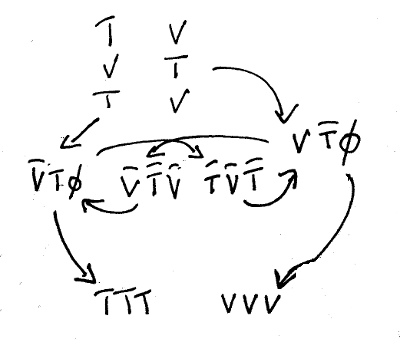 figurePion phase-transition to positron (e+) and neutrino (ve)
figurePion phase-transition to positron (e+) and neutrino (ve)
|
Here we have something that at first glance seems very strange: two non-matching intermediate particles (anti-u and a down quark) appear to have been brought into existence for the purposes of satisfying some arbitrary application of some equations. Looking closer however we note that two critical and very interesting things, when taken together (bearing in mind also that this is merely a mathematical representation of the overall result).
Recall above that it was hypothesised that a bare neutron's existence with its +1V charge would be quite disruptive to surrounding particles: imagine now what the presence of two quarks with 1/3 charge and 2/3 charge would do. It is not unreasonable therefore to imagine that the passage of a Pion+ through space, surrounded by stable matter with unit charges, would leave a chaotic trail of up-anti-up and down-anti-down particles in its wake (aka Pion0 particles), as well as an anti-Pion being created even briefly as the universe attempts to cancel out the Pion, or even briefly creating Pion-anti-Pion pairs.
Also, almost in passing, it is worthwhile noting that the Pion+ has two positive charges: a +1 T charge and a +1 V charge. Likewise, a Pion- would have -1 T charge and -1 V charge. As such, the Pion+ and Pion- would logically act as the mediator of interactions between nucleons. However there may be a simpler - or perhaps simply different - explanation (covered later) in which these two Pions would merely be convenient artefacts.
In light of the above, the next example phase-transition - a Pion to a Muon
and Muon-neutrino - can be attempted. Bear in mind that the Muon and
the Muon-neutrino fit the 9-Rishon I-Frame pattern:
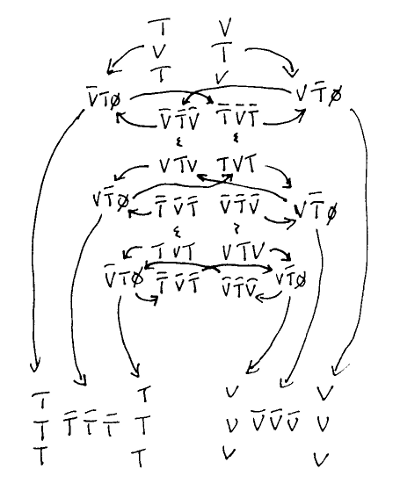 figureFirst attempt at Pion phase-transition to muon and muon-neutrino
figureFirst attempt at Pion phase-transition to muon and muon-neutrino
|
Starting at the top of this (comprehensive!) diagram is the up and anti-down quarks (TVT and VTV). Two quark-anti-quark pairs (which happen both to be Pion0's in both electron and neutrino flavours) are brought into existence, and one quark from each immediately results in a transition that creates on one side the first electron of the Muon and on the other side the first neutrino of the Muon-Neutrino. The opposing quark is used as the input from the other phase transition in the pair, in exactly the same way as was described in the previous (simpler) decay.
At the same time, from the opposite quark of the two Pion0's (in each flavour) the exact same loop-linked phase-transition occurs to create the positron and the anti-neutrino of the Muon and Muon-Neutrino. Finally, and again, at the exact same time, just as with the previous simpler decay, an anti-Pion is brought into existence with a final loop-linked phase transition that results in the last two triplets to complete each of the Muons.
However, sharp-eyed readers will have noted a problem with the diagram above: four of the Rishon triplets have no incoming transforms to cancel them out. After considerable analysis and experimentation attempting to find a solution that respects the paired phase-transition rule, reluctantly it was concluded that there must be a new rule to deal with this type of situation, which is named "VT*":
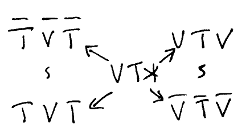 figureintroduction of VT* solves issue of unbalanced VT0 phase shifts
figureintroduction of VT* solves issue of unbalanced VT0 phase shifts
|
VT* is in effect the simultaneous introduction of a Pion+ and Pion-. The primary reason for its introduction is shown, later, to be involved in the creation and "decay" of W Bosons. Does VT* violate any laws of conservation of energy? no it does not. why not? because each particle completely cancels out with every other particle. It is suspected that the phases of each of the three Rishon particles in each of the four triplets also are required to match: this will be dealt with separately in the section covering colour.
What is the primary "decay" path of a Pion+? It transforms via a W-Boson into a pair of muons. The justification for the make-up of a W-Boson is covered in a separate section, later, but for now its creation is assumed to be understood, as an intermediate means to explain the Pion+ to muon and muon-neutrino transformation. The first step is for the Pion+ to transform into a W-Boson:
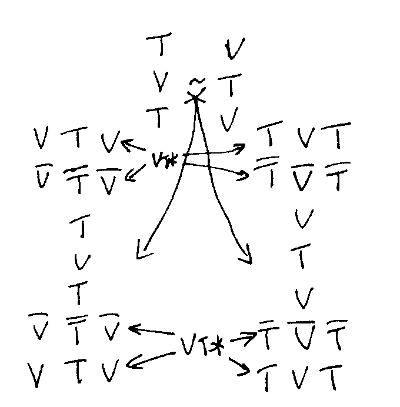 figurePion+ transforms into W+ Boson with two spontaneous VT* events
figurePion+ transforms into W+ Boson with two spontaneous VT* events
|
Here - again with no laws of conservation of energy violated - the Pion+ has transformed into a pair of ultra-heavy quarks (explained below), and formed a W+ Boson. How - or why - would this event occur? If this event was to be explained from a purely observational perspective, it could be considered to be a similar occurrence to that type of event which neutrinos undergo: flavour oscillation.
However, consider the mechanics and the background. Two quarks - an up and an anti-down - both of them highly disruptive fractionally-charged particles surrounded by a sea of matter that has unit charge, sail through space in an unstable rotating pattern. Due to their unique properties they cannot ever collide and annihilate. As they come closer to each other, with nothing to prevent them from doing that, their rate of rotation around each other becomes ever faster, causing huge disruption of their immediate space. This localised disruption is likely to be sufficient to allow space for the two VT* events to occur, bringing into existence two sets of Pion+ particles and two sets of Pion-. These pairs "attach" themselves to each of the up and down quarks, allowing them to reach a more stable arrangement (in fact, looking closely at these two sets of ultra-heavy quarks we note at the centre of each is the exact same Rishon arrangement for a neutron an a proton).
So this is the first step: the Pion+ transforms into a W+ Boson (to be re-classified and explained later). The next step is for the W+ Boson to undergo a series of simultaneous phase transforms into a muon and muon neutrino:
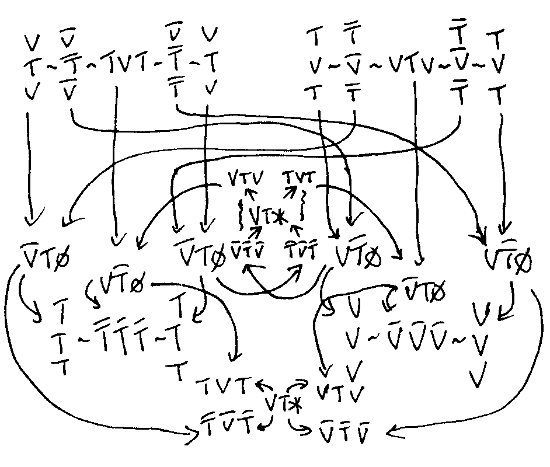 figureW+ Boson transforms into muon and muon-neutrino
figureW+ Boson transforms into muon and muon-neutrino
|
The phase-transformation above is not as spectacularly complex as it first seems! Firstly, bear in mind that the two ultra-quarks will be rotating one about the other (not laid out in a straight line as shown above). The two ultra-quarks transform directly into a muon and muon-neutrino with only one phase-shift per triplet. The ultra-up quark becomes the muon: the anti-ultra-down becomes the muon-neutrino, but we see that in fact (from the crossing-over arrows) that the phase shift occurs through using triplets from both quarks.
There are however not quite enough quarks to complete the phase-shift: there are ten input triplets (from the W+ Boson) yet only six outputs left after the transformation. This is where the two VT* phase transformations come into play. The lower VT* absorbs the four quarks that came from four of the muon's phase shifts. The other VT* transformation (towards the middle of the diagram above) is, in a Feynmann-style arrangement, taking one pair of anti-down and up quarks from one matched set of VT0 phase-shifts, exchanging them for a pair of down and anti-up quarks and then feeding those back into another matched pair of VT0 phase-shifts. Again note that whether this latter VT* transform is actually the case is open to debate: mathematically however it is "correct".
In this rather convoluted way - a way which could probably be better expressed in less cumbersome terms - a mathematical representation is presented which at the very least shows that the entire shift, right the way from the original pion through to the final muon and muon-neutrino, conserves charge across both T and V matter and without any particles "left over". If new T or V particles were introduced, it was done in a way that is completely balanced, as well as having a reasonable and rational explanation as to why it might occur.
Lastly on this example: the occurrence of two VT* transforms in both the creation and destruction of the temporary W+ Boson is probably a coincidence, but is worthwhile bearing in mind when examining future phase transforms. As the W+ Boson is considered to be the "weak force", there is a considerable gap between the two sets (of two) VT* transforms, leaving any thought of conservation of VT* transforms (in a similar fashion to VT0 pairs) as being on pretty shaky ground.
lkcl 2016-12-29